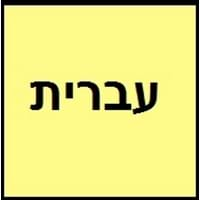Hebrew vs Sundanese
Countries
Israel
West Java
National Language
Israel
Indonesia
Second Language
Israel
Not spoken in any of the countries
Speaking Continents
Africa, Asia, Europe
Asia
Minority Language
Poland
Not spoken in any of the countries
Regulated By
Academy of the Hebrew Language
Not Available
Interesting Facts
- The original language of Bible is Hebrew.
- The men and women use different verbs in hebrew language.
- The Sundanese language is second most widely spoken regional language in Indonesia.
Similar To
Arabic and Aramaic languages
Madurese and Malay Languages
Derived From
Aramaic Language
Not Available
Alphabets in
Hebrew-Alphabets.jpg#200
Sundanese-Alphabets.jpg#200
Scripts
Hebrew
Latin, Sundanese
Writing Direction
Right-To-Left, Horizontal
Left-To-Right, Horizontal
Language Levels
Not Available
Time Taken to Learn
Not Available
Thank You
תודה (Toda)
Nuhun
How Are You?
מה שלומך? (ma shlomxa)
Kumaha kabarna?
Good Night
לילה טוב (Laila tov)
Wilujeng kulem
Good Evening
ערב טוב (Erev tov)
Wilujeng wengi
Good Afternoon
אחר צהריים טובים (Achar tzahara'im tovim)
Wilujeng siang
Good Morning
בוקר טוב (Boker tov)
Wilujeng énjing
Please
בבקשה (bevekshah)
Mangga
Sorry
סליחה! (Slicha)
Hapunten
Bye
להתראות (Lehitraot)
Wilujeng angkat
I Love You
אני אוהבת אותך (Ani ohevet otcha)
Abdi bogoh ka anjeun
Dialect 1
Ashkenazi Hebrew
Western dialect
Where They Speak
Israel
Banten
Dialect 2
Samaritan Hebrew
Northern dialect
Where They Speak
Israel, Palestine
Bogor
Dialect 3
Yemenite Hebrew
Priangan dialect
Where They Speak
Israel
Bandung
Speaking Population
Not Available
Second Language Speakers
Not Available
Native Name
עברית / עִבְרִית (ivrit)
Not Available
Alternative Names
Israeli, Ivrit
Priangan, Sunda
French Name
hébreu
soundanais
German Name
Hebräisch
Sundanesisch
Pronunciation
[(ʔ)ivˈʁit] - [(ʔ)ivˈɾit]
Not Available
Ethnicity
Not Available
Sundanese, Bantenese, Cirebonese, Badui
Origin
1000 BC
5th century AD
Language Family
Afro-Asiatic Family
Austronesian Family
Subgroup
Semitic
Indonesian
Branch
Canaanitic
Not Available
Early Forms
Biblical Hebrew, Mishnaic Hebrew, Medieval Hebrew, Hebrew
No early forms
Standard Forms
Modern Hebrew
Sundanese
Language Position
Not Available
Signed Forms
Signed Hebrew
Not Available
Scope
Individual
Individual
ISO 639 6
Not Available
Not Available
Glottocode
hebr1246
sund1251
Linguasphere
12-AAB-a
No data available
Language Type
Living
Living
Language Linguistic Typology
Subject-Verb-Object, Verb-Subject-Object
Subject-Verb-Object
Language Morphological Typology
Fusional, Synthetic
Not Available
Hebrew and Sundanese Language History
Comparison of Hebrew vs Sundanese language history gives us differences between origin of Hebrew and Sundanese language. History of Hebrew language states that this language originated in 1000 BC whereas history of Sundanese language states that this language originated in 5th century AD. Family of the language also forms a part of history of that language. More on language families of these languages can be found out on Hebrew and Sundanese Language History.
Hebrew and Sundanese Greetings
People around the world use different languages to interact with each other. Even if we cannot communicate fluently in any language, it will always be beneficial to know about some of the common greetings or phrases from that language. This is where Hebrew and Sundanese greetings helps you to understand basic phrases in Hebrew and Sundanese language. Hebrew word for "Hello" is שלום (Shalom) or Sundanese word for "Thank You" is Nuhun. Find more of such common Hebrew Greetings and Sundanese Greetings. These greetings will help you to be more confident when conversing with natives that speak these languages.
Hebrew vs Sundanese Difficulty
The Hebrew vs Sundanese difficulty level basically depends on the number of Hebrew Alphabets and Sundanese Alphabets. Also the number of vowels and consonants in the language plays an important role in deciding the difficulty level of that language. The important points to be considered when we compare Hebrew and Sundanese are the origin, speaking countries, language family, different greetings, speaking population of these languages. Want to know in Hebrew and Sundanese, which language is harder to learn? Time required to learn Hebrew is 44 weeks while to learn Sundanese time required is Not Available.





